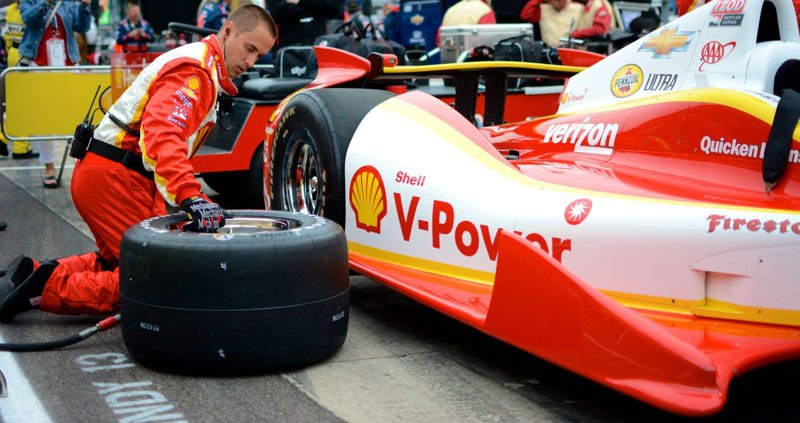
A Racing Dream Realized at the Indianapolis 500

Since I was a little girl, I’ve been captivated by cars. Seemingly born with my hands at ten and two, I started driving on dirt roads when I was seven-years old. My first car came at the age of thirteen–a classic, mint condition ’66 Mustang. That’s also the age I discovered my lead foot. A simple turn of the key and the rumble of the 289 V-8 engine left me feeling euphoric.
During the late ‘80s there was no Danica Patrick for inspiration, thus my dream of becoming a professional race car driver faded, while more practical occupations took its place. As fortune would have it, nearly three decades later my racing fascination was reignited with an invitation to Indiana—during the Indianapolis 500.
Come the month of May, the eyes of the racing world are firmly planted on Indianapolis. Since 1911, the Indianapolis Motor Speedway has played host to “The Greatest Spectacle in Racing,” otherwise known as the Indianapolis 500. On the last Sunday of the month, in conjunction with Memorial Day weekend, thirty-three of the best drivers compete for the honor of having their name and face immortalized on The Borg-Warner Trophy, one of the most coveted prizes in sports. The trophy and a place in history aside, the winner also nabs a piece of the approximately $12,000,000 purse.
Indianapolis is the birthplace of IndyCar, and racing courses through the veins of this city. I was made acutely aware of this fact the moment I stepped off the plane. Signage touting the weekend’s events covered the airport. Passengers wielding smart phones clamored around the IndyCars that sat gleaming throughout the terminals, just waiting to capture their next Facebook profile photo. The energy was palpable, and it was only Thursday. Standing at the baggage claim, I really had no idea what the weekend had in store, but a limo pickup is often an indication of great things to come.
Watching names like Andretti, Castroneves and Franchitti buzzing around the 2.5-mile track at 150 miles per hour are what fill the Indianapolis Motor Speedway’s 250,000+ permanent seats, right? Perhaps, but the actual race is just a piece of what the Indianapolis 500 entails. The pageantry of the weekend is akin to Pasadena’s Rose Bowl, combined with the tradition of the Kentucky Derby and the party atmosphere of the Super Bowl. The Indy 500 is far from just a race—it’s an occasion, one that television doesn’t do justice. 
While picking up my press credentials for the weekend, I got my first glimpse of the Indianapolis Motor Speedway. The sheer size of the venue sets the tone for the magnitude of the event. It’s claimed that Yankee Stadium, the Roman Colosseum, the Vatican and Churchill Downs all fit inside the track’s oval. If that’s not a staggering enough statistic, the complex also has an 18-hole golf course, Hall of Fame Museum, twenty-six bridges, six tunnels and 220 acres of grandstands. Had I not seen the place with my own eyes I wouldn’t have believed it–spectacle is right.
After the mini-marathon, parade, Breakfast at the Brickyard, concerts, Memorial Service and every other sort of event imaginable has concluded, the attention of city is set on the actual race. As the most attended sporting event in the United States, around 300,000 people pour into the grandstands and infield.
The Indy 500 experience is different for everyone. Veteran spectators are staunch in their traditions. They’d rather change family Christmas than deviate from their routine. Those that attend for the party can be found inside of turn three, better known as the Snake Pitt. The debauchery that takes place there is stuff of legends. Then there’s the VIP experience—the one I had.
The drive from downtown to the Indianapolis Motor Speedway took no time thanks to the chartered bus and police escort. In a matter of thirty minutes, I was flashing my media credentials and walking on to the track. It was then that I understood the magnitude of the moment. 
Brightly colored cars with massive amounts of stickers lined the pits. Tires were taken off and put back on just as quickly. Engines roared so loudly I reached for my ears. The reverberation of the cars could be felt in my feet. Men in matching jumpsuits scurried about making last-minute adjustments. Team owners milled about glad-handing well wishers. I was in the eye of the racing storm. And with the madness surrounding me, I got on my knees and kissed the fabled bricks along the start/finish line.
As race time neared, the gold-clad team of security ushered non-race personnel into the spectator area. I was able to avoid their sweep and kept myself firmly planted on the track. This experience was thirty years in the making, and I was not ready for the moment to end. There I stood, shoulder to shoulder with team owners and drivers’ wives. I could sense their nervous energy.
Three by three, the drivers were introduced to the hundreds of thousands adoring fans. Indiana native, Jim Nabors of Gomer Pyle fame, belted out “Back Home Again in Indiana.” The military of past and present was honored with a flyover and thousands of balloons were released. I’d seen this all before on television, but now the pomp and circumstance took on a different meaning. I was part of something bigger than myself—I was part of history, at least in my mind.
I couldn’t escape the ever-watching eye of security any longer and was all but drug off the track. Determined to not miss the start of the race, I powered through the crowd who were deftly balancing beers and hot dogs in their hands. Again I flashed my badge, and barged my way into the full elevator. Once the doors opened, I hustled to my assigned suite just in time to hear the starter utter the most famous words in the motorsports world.
“Ladies and gentlemen, start your engines.”
And with the roar of the IndyCars on the track below, I was taken back to my ’66 Mustang and that same euphoric feeling. The Indianapolis 500 is the pinnacle of racing, and I experienced it like few others.












































